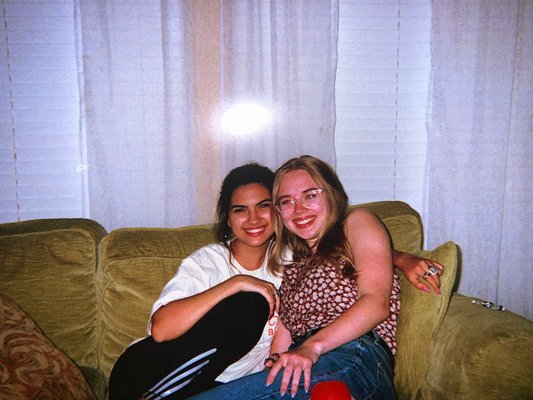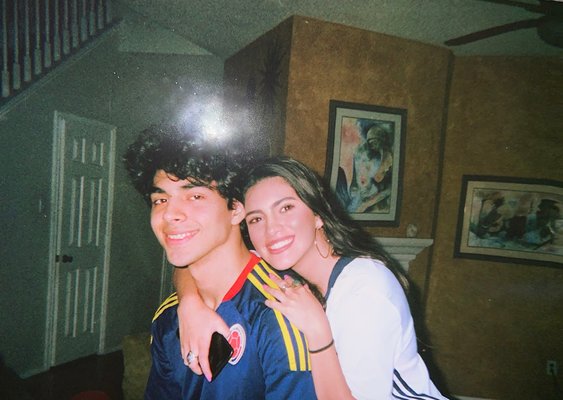How Overcoming an Eating Disorder Shaped My Identity as a Second Generation Latina
Jia WeedonGrowing up, it felt like superficiality dominated societal standards. Whether it was achieving a thigh gap in 2012 or a trademark Kardashian hourglass body figure in 2018, I was constantly being exposed to impossible beauty standards that came and went almost as quickly as fast fashion trends themselves. For as long as I can remember, I’ve struggled balancing the weight of these impossible beauty standards in addition to the pressures, tropes, sexualization, and misogyny that came with being a second-generation Latina.
Don’t get me wrong! Although I’m incredibly proud to be the daughter of Colombian immigrants, there was a time in my life when I heavily rejected nearly every aspect of my cultural background out of fear, resentment, and shame. I went to elementary, middle, and high school in a suburban, predominantly white town in North Texas - so, naturally I stuck out from my classmates like a sore thumb. While every other girl in my kindergarten class was blessed with beautiful blonde hair and blue eyes, I was stuck with the thick unruly curls and big brown eyes I had inherited from my parents. As time went on, the physical differences between my classmates and myself became much more pronounced.
Simple questions that stemmed from the curiosity of my peers would send me into a spiral. Their eyes wide with curiosity and wonder, my friends would ask why I had hair on my arms. What began as an innocent question turned into an obsession in my eyes. I became fixated and repulsed by the amount of dark body hair on my arms, in comparison to the invisible peach fuzz that grew on their arms. So, I took matters into my own hands in third grade. I stole my dad’s facial razor and started shaving my body hair. They asked why my parents spoke in a funny accent, so I asked my mom and dad not to speak to me around my friends at school. They made fun of my name in front of my teachers, so I told my mom I was going to change my name to Britney (after Britney Jean Spears, of course) the second I moved out. As I suppressed more of my individuality, it quickly became clear to me that I was drowning in the discomfort of my own existence.

Looking back, my heart aches for the little brown girl with glasses who used to search for herself in every magazine cover, movie, tv show, book, and commercial she ever saw. Even the Colombian role models I was supposed to look up to looked nothing like me. Shakira? White passing with blonde hair. Sofia Vergara? White passing with blonde hair and green eyes. Paola Turbay? White passing with blonde hair and green eyes. I was supposed to love them, to be inspired by them - to be proud to be like them. But I wasn’t like them at all. And every time I looked at them, I grew angrier and more ashamed of my appearance.
After a few years, the pressures of living in an artificial, heterogenous world driven by impossible beauty standards had manifested into many consequences in my adult life - including body dysmorphia and disordered eating that began during my adolescent years. What began with me silently counting calories on an iPod Touch app, quickly turned into an obsession with scanning rooms and comparing my body to that of every woman around me. I’d get a small thrill from measuring how much space my squished legs would take up in my chair compared to the girls sitting right next to me. Or the instant gratification I would feel if someone asked me if I had been working out as we got up to walk to our next class. I’d smile and shake my head. They didn’t know I spent 3 hours walking on an inclined treadmill, or that I had been skipping breakfast for the past month. Nobody knew about my eating disorder when it began, which made it that much more exciting - but equally as shameful. How could the habits that made me feel so good about myself also make me feel so guilty and alone?
Middle school was miserable enough - add a couple of mean girls and the introduction of social media and - boom. By the age of 12, I was regularly binge-eating junk food during the day and purging it right back up at night. It would be years until I admitted to myself that I had a rampant eating disorder, let alone found the courage to seek help. If I couldn’t control my name, my hair color, my eye color, or my skin color, then I’d find something else to control. My body - and my food consumption. If I couldn’t be blonde, then I’d try to be thin. If I couldn’t have blue eyes, then I vowed to fit into a size 0 if it was the last thing I ever did.
It’s not that my parents weren’t supportive during this time, but they’ve definitely come a long way. When I began to show early signs of depression and disordered eating, they didn’t have the tools to support me the way I needed to be supported. So, they began to take me to pediatricians, dieticians, and nutritionists to search for a logical answer. I don’t think mental illness or eating disorders ever occurred to them. For one, food is one of the most integral elements of Latinx culture. Many Hispanic and Latinx families refuse to wrap their heads around the fact that anyone could struggle that much with food - let alone fear it. Secondly, it was always implied to me that we simply had bigger problems than worrying about mental health. Going to therapy was expensive - and only for people that were “really sick in the head,” according to my parents. So, not for me nor my brother.
In my parents’ eyes, my brother and I were perfectly fine all the time. And…we were. On the outside. On the inside, I know my younger brother and I felt forced to bottle up and conceal our emotions, both out of fear and guilt. We never really talked about our feelings in my house openly and honestly like other people might have. We just felt lucky to be raised in a health-conscious household that actually discouraged restricted eating and “dietas” that are often normalized in Latinx culture, particularly between mothers and daughters.

But if we cried or showed signs of sadness and depression, we were always instructed to stop, wipe our tears, and keep our heads up. If we tried to open up about our emotional struggles, or even tried to discuss our mental health, we were quickly labeled as dramatic. Over the top. Ungrateful. We were constantly reminded that our parents had a harder upbringing than we did and that we should be grateful to live the way that we do, regardless of how we feel inside. Too often the antiquated “we don’t talk about those things” mentality keeps Latinx people chained to their traumas and illnesses. Moreover, these approaches are usually learned behaviors that have maintained generational cycles of both abuse and trauma. In my (many, many, many) moments of teary-eyed frustration, I really have to remind myself that older generations were simply born into environments that were far different than the one I grew up in.
It wasn’t until I moved out and went away to college that I began going to therapy sessions. Not only was I taught valuable coping mechanisms for obsessive thought patterns that often come with eating disorders, but I was able to take up space freely without feeling guilty or censoring myself. I was allowed to be angry. I was allowed to cry. I was allowed to feel. I didn’t know it at the time, but going to these first therapy sessions saved my life. After so many years of neglecting my mental health, sweeping emotions under the rug, and hiding in the darkest corners of my room - I found solace in a university therapist’s office in the middle of Denton, Texas. But more importantly, I was finally giving myself permission to let go. To let go of superficiality. To let go of impossible standards. To let go of cultural norms.
It certainly didn’t happen overnight, but the liberation I’ve felt since going to therapy has been astounding. Instead of concealing my differences out of shame, I find every excuse to celebrate them. I love my thick, unruly hair (when it cooperates with me, of course). I love Colombia. I love speaking Spanish. I love the fact that my skin tans so beautifully in the sun. I love listening to vallenatos Colombianos. I love everything about myself and my identity and have learned to separate my self-worth from the cultural norms and societal standards I was raised with. While there’s no doubt in my mind that I’ll have to work on my relationship with my body and with food for the rest of my life, I’ve been lucky enough to be blessed with a phenomenal support system that includes great friends, lots of safe spaces, access to mental health services, and the unconditional love of my family members.
If you are a Latinx, or know of a Latinx person struggling with an eating disorder, here are a few helpful resources and articles for the Latinx community:
Your Latina Nutritionist
How My Experience with Anorexia Influenced my Identity as a Latina
My Journey and Why Latinas with Eating Disorders Matter
Nalgona Positivity Pride
--

Anise Health is the first culturally-responsive digital mental health platform offering therapy, coaching, and digital self-service tools that are tailored for the unique needs of communities of color. Our interventions move away from diagnosis-driven, Eurocentric models and towards incorporating culture and intersectionality into evidence-based treatments, which research shows to be 5x more effective.
Interested?
Anise is live in California and is currently accepting Asian-identifying adults (ages 18+) and partners/family members as new clients. Get started by filling out our short intake form; you will be matched to culturally-responsive clinicians within 2 business days. If you identify with another community of color or reside in another state, sign up for the distribution list on our website to be the first to know about upcoming launches!
